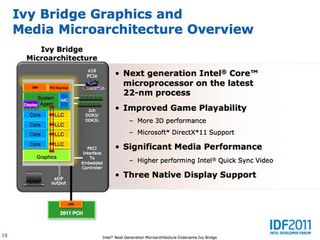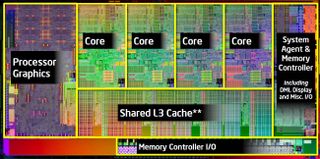Intel: AMD is Still a "Serious Competitor" ... on Price
In a third interview with Nordic Hardware, Pat Bliemer, the Managing Director of Intel Northern Europe, discusses AMD's Llano, Integrated Graphics and how it can compete in the market.

Nordic Hardware asked Mr. Bliemer if AMD gaining in any segment thanks to the performance of Llano, which has been very successful for AMD. In his comments, Mr. Bliemer acknowledges (in a roundabout way) that AMD has the lead in the Llano & Brazos market segment. Intel still sees AMD as a serious competitor, but more in the price-to-performance arena versus pure performance power. This is interesting giving that AMD plans to shift its focus away from competing with long-time processor rival Intel starting in 2012.
"AMD is and will always be a serious competitor of ours. I do think that based on where we started this discussion, particularly on the manufacturing side and the lead that we have with architecture and manufacturing that it has been alot [sic] harder to them to compete effectively against us. So therefor [sic] most of it is price driven, so I would say if there's an area - we have to always continue to make sure we will remain competitive in the low end of notebooks right now, which is largely fueled by their Llano and Brazos products that actually go into that segment. So it's a pricing game but I think that from a performance and experience point of view it is not much for them right now to really pleased about I think. But they will always stay competitive."- Pat Bliemer, the Managing Director of Intel Northern Europe
Mr. Bliemer discussed the future of integrated graphics and how it can compete in today's market with discrete graphics solutions. Being a PC enthusiast and gamer, I find it hard to believe that integrated graphics solution has any value for the end-user. It is not until I take a step back and realize that I am not the majority but a very low minority in the grand theme of needs / usage. This is the battle Intel and AMD alike have to battle on how to convince consumers that integrated solutions are sufficient. With AMD's Llano and the changes coming to the integrated graphics on Ivy Bridge (HD 4000), we are seeing how the integrated graphics solution is capable of playing HD content, games or accelerating applications better than ever before.

"The future goal is certainly not that we have a vision or so that in a few years time there’s not going to be any external graphics solutions available any longer. We do not think that 100 percent of the market is going to go integrated. We do think that more people will realize that they, what actually they have in their default is good enough to run 99,98 percent of the things that they do. If you talk about mainstream gaming you can elegantly do it already based on GT2 [Intel HD 3000] solutions that we have. If you want to go do something like some of the real serious games that these guys are playing here behind us [at Dreamhack], then you have the need for external graphics." - Pat Bliemer, the Managing Director of Intel Northern Europe

Read more on the interview at Nordic Hardware.
Stay on the Cutting Edge
Join the experts who read Tom's Hardware for the inside track on enthusiast PC tech news — and have for over 25 years. We'll send breaking news and in-depth reviews of CPUs, GPUs, AI, maker hardware and more straight to your inbox.
-
rozz oh.. he's just saying that so the government doesnt step in to stop AMD from leaving the market and making intel a monopoly..Reply -
exban224 rozzoh.. he's just saying that so the government doesnt step in to stop AMD from leaving the market and making intel a monopoly..i do agree.Reply
if amd can claim that intel are making a monopoly of the market they have themselves to blame for bull-dozer. -
Why can't they just do a enthusiast version of i7 and use that wasted graphic space on 1 or 2 extra cores? That would also help to differentiate the increasingly blurry lines between i5 and i7. Or better yet remove them and lower the price of the cpu.Reply
I'm pretty sure they would've been doing that if AMD had been more competitive. Now it just feel like intel is too comfortable and decided not to push cpu performance as much as they can. Instead they decided to work on screwing AMD on low end graphic card sales and squeeze the last breath of air out of them.
Karma will get them though. ARM's SoCs is catching up real fast. And Intel's SoC approach will only weaken its position against it as it loses its performance edge partly thanks to its lost focus on pure CPU performance. -
SpadeM Bulldozer as it is now reminds me of the first Athlon 64 (for younger readers check this platform preview http://www.xbitlabs.com/articles/cpu/display/athlon64_8.html). The Athlong 64 lost in benchmarks to intel and even the previous Athlon XP (kind of like Bulldozer is doing now) and it also had "new and useless consumer tech" like the x86-64 instruction set (or bulldozer modules now). But we all know how things turned out a year later. All I'm sayn is that ppl should give AMD the benefit of the doubt, a thing that intel through mr. Pat Bliemer is doing.Reply
PS: I do understand bragging rights but as a side note, I think it's a bad decision to increase performance withing a CPU and leave other sectors behind. I don't want Intel to make a hexa core sandy bridge or ivy bridge cpu that is 5 times faster then the 2600K at the same price, if they're still selling me a platform that has no nativ usb 3, full sas/sata 6, pci 3 or newer ddr+ssd combo tech thing, ready to take advantage of that power. I'm all for progress, but on all playing fields. -
rawful Somehow I feel like Intel and AMD both know what they are doing better than anyone leaving comments about them.Reply -
DavidC1 SpadeMBulldozer as it is now reminds me of the first Athlon 64 (for younger readers check this platform preview http://www.xbitlabs.com/articles/cpu/display/athlon64_8.html). The Athlong 64 lost in benchmarks to intel and even the previous Athlon XP (kind of like Bulldozer is doing now) and it also had "new and useless consumer tech" like the x86-64 instruction set (or bulldozer modules now). But we all know how things turned out a year later. All I'm sayn is that ppl should give AMD the benefit of the doubt, a thing that intel through mr. Pat Bliemer is doing.Reply
WTF are you blabbering about? Athlon 64 on the real part kicked ass: http://www.xbitlabs.com/articles/cpu/display/athlon64-3200_7.html#sect0
Athlon 64 before launch: low performance
Athlon 64 on a real launch: high performance
Bulldozer hype before launch: game changing performance
Bulldozer performance after launch: has to go all out just to outperform their own CPU
Why can't they just do a enthusiast version of i7 and use that wasted graphic space on 1 or 2 extra cores? That would also help to differentiate the increasingly blurry lines between i5 and i7. Or better yet remove them and lower the price of the cpu.
Anonymous, there's no point in doing that. The 70-80% of the people are more than subsidizing the minute extra cost graphics might add. More because Intel is a production powerhouse.
About ARM: What you said about integrated graphics is counter to what you said about Intel's SoC approach.
I thought ARM was all about performance too. Look at their claims with A15 and Nvidia with their 8+ core claims coming in the future. When they scale up to try to compete in performance, they will lose all the power efficiency advantage. Just look at how other RISC vendors go against Intel. -
jdwii ReplyIf you talk about mainstream gaming you can elegantly do it already based on GT2 solutions that we have.
LOL
HA HA Intel is so funny, Can they even play 24fps videos now? Ha i built a Intel machine thinking their 3000HD graphics where enough for sims 3 and small games like that but it skipped so badly. I can't even watch a blu-ray movie on it without dropped fps. I wonder how good the 4000HD graphics will be? Well the 4000HD graphics only be on more expensive cpu's for 150+$ or will they make them for their lower-end cpu's as well? Most people who have I5 or better probably have a video card through nvidia or Amd. As i always say i want my graphics card to be even with my CPU in performance. I don' t want a crappy GPU with a I7 and i don't want a 6990 with a Dual-core Athlon.
People use graphics more and more they are probably getting used more then CPU's now a days. For things like GPU acceleration and such. -
jdwii ReplyI thought ARM was all about performance too. Look at their claims with A15 and Nvidia with their 8+ core claims coming in the future. When they scale up to try to compete in performance, they will lose all the power efficiency advantage. Just look at how other RISC vendors go against Intel.
Arm will never make it on the desktop and laptop market if no programs even work for it that's made today on windows. Just think how pissed people will be to see all their games or old programs will not work. Not to mention a Arm core is like a Atom. Slow. Who needs a 8 core Atom(Arm). Look at the 8 core BD that even sucks just think about a 8 core arm. -
waethorn It made me laugh when he mentioned "Intel HD graphics" and "gaming" in the same sentence.Reply
Any time Intel talks about their chips being "good enough for 99.99% of what average people do", I cringe. Their chips are a major compromise over what you get with a decent GPU, and AMD is basically throwing that functionality in for free when you buy a low-mid range APU, meaning that you get more for your money. Programs like IE9, Flash, Office 2010, Windows Live Photo Gallery, Windows Media Foundation with H.264, etc., all use GPU acceleration, and those programs cover "99.99%" of what people like to use their computer for, not to mention that Windows Aero doesn't suffer any with the extra GPU cores. And Intel tries to compare their lackluster DX10 parts to AMD's APU gfx cores.... Intel doesn't get graphics, and I wouldn't like to see a tablet with an Intel processor in it, considering that most people use tablets for media consumption. This is probably why AMD is working with ARM to get ARM cores combined with their Radeon GPU cores into a new APU. The next real heterogenous computing platform is going to be provided by AMD. As of right now, AMD's new offerings of RAM is an awesome option because they're creating as close as is possible to a single-vendor solution for validated systems. I think of it more like a console-ification of PC building. What I'd like to see next from AMD is to create some kind of PC certification system with Microsoft. If a system builder builds a system with certain "class-A" components with AMD branding (including the new RAM), it should also pass WHQL certification for logo testing with Windows. It would need to have pre-certified drivers, but AMD should include the component cross-compatibility validation so that WHQL tests pass automatically.
Most Popular

